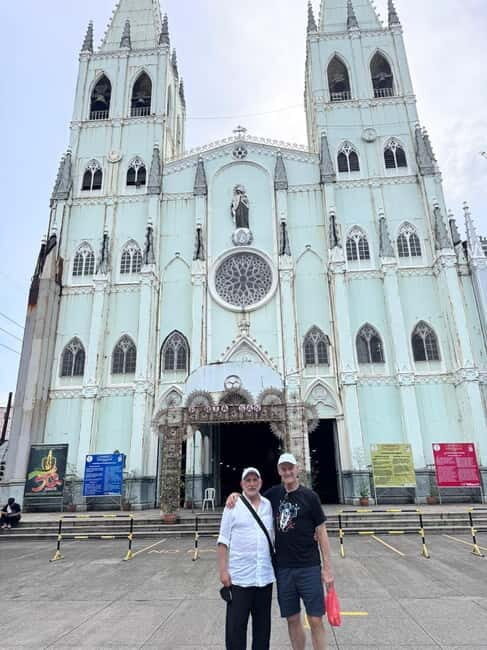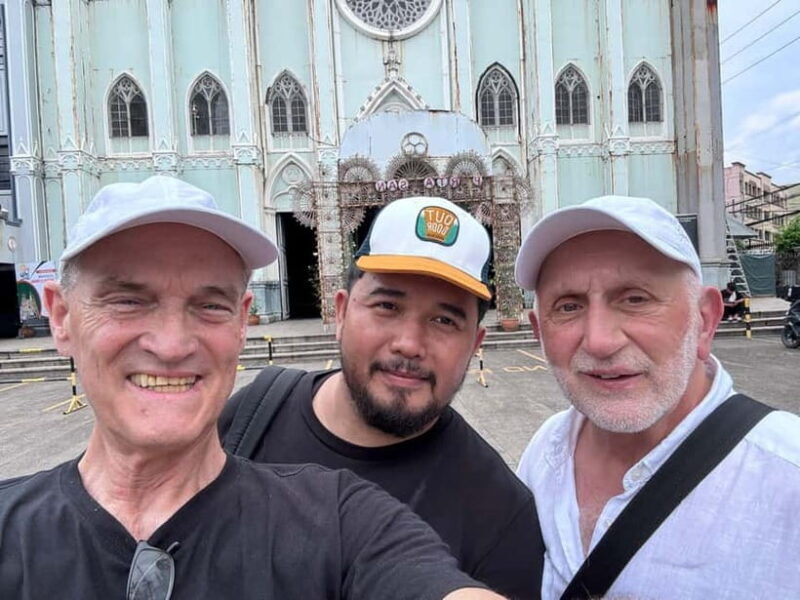Manila: City Tour with Food Tasting and Guide offers an engaging way to explore the Filipino capital’s layered history and vibrant street life for $850 per group of up to six people. Led by a friendly local guide, the tour takes you through Manila’s most iconic neighborhoods—Quiapo, Intramuros, and Binondo—with stops that reveal the city’s rich tapestry of faith, colonization, and cultural resilience.
What we love most about this experience is how it balances history and local flavor. The chance to walk through cobbled streets of Intramuros while hearing stories of resistance and revolution makes history come alive. Plus, the food tasting—whether a hearty Filipino lunch or snacks—gives you a delicious window into how trade, colonization, and tradition shape Filipino cuisine.
A possible drawback is that the tour involves a moderate amount of walking, which could be tiring for some travelers, especially in hot weather. Also, the focus on many sites means time is limited at each stop, so if you’re after deep dives into a single neighborhood, this might feel a bit rushed.
This tour suits travelers who appreciate authentic cultural experiences, enjoy trying new foods, and prefer guided insights rather than wandering aimlessly. If you want a well-rounded, immersive day that introduces you to Manila’s soul and stories, this tour hits the mark.
Key Points

- Authentic Neighborhoods: Explore Quiapo’s spiritual mix, Intramuros’ colonial charm, and Binondo’s bustling Chinatown.
- Cultural Insights: Learn how Filipino folk Catholicism and pre-colonial beliefs continue to influence daily life.
- Culinary Delights: Taste Filipino-Spanish dishes, street snacks, and discover how history shaped local flavors.
- Historically Rich Sites: Visit UNESCO-listed San Agustin Church and Fort Santiago, hearing stories that textbooks often overlook.
- Local Guides: Benefit from a friendly bilingual guide who brings Manila’s stories to life.
- Flexible Booking: Reserve now and pay later with a full refund available if canceled 24 hours in advance.
A Detailed Look at Manila’s Most Engaging Tour

Appreciate having local insight? Here are other guided experiences in Manila we've examined
Starting in Quiapo: Faith, Street Life, and Mysticism
The tour begins in Quiapo, often described as Manila’s spiritual heart. Here, the Minor Basilica of the Black Nazarene is a magnet for devout Catholics, and you will see thousands flocking to its doors in prayer. We appreciated how our guide, Maria, explained the significance of this site and shared personal stories about the pilgrims’ faith.
But Quiapo isn’t just about Catholic devotion. It’s a melting pot of faiths and cultures. Just a few blocks away, you’ll find the Muslim quarter, where mosques, halal eateries, and folk healers sit side by side. It’s a wonderful reminder of Manila’s religious diversity, which is often overlooked.
We loved wandering through hidden alleys, discovering herbalists, fortune-tellers, and vendors selling anting-anting—small amulets believed to ward off evil. This mix of folk Catholicism and pre-colonial animism lives on in everyday life. Our guide explained how these traditions coexist, offering a glimpse into Filipino spirituality that isn’t always evident in tourist brochures.
Taking in the Colonial Past: Intramuros
Next, we stepped into Intramuros, the original Spanish walled city founded in 1571. Walking along cobbled streets, we felt transported back centuries, with historic buildings and ruins whispering stories of conquest, resistance, and resilience. Our guide emphasized that Intramuros isn’t just about old walls; it’s where Filipino history was shaped, often in quiet defiance.
A highlight here was the San Agustin Church, a UNESCO World Heritage site. Its intricate baroque architecture and centuries-old paintings offer a tangible link to the Philippines’ colonial past. You’ll also visit Fort Santiago, where José Rizal, the national hero, was imprisoned. Listening to stories of Rizal’s resistance and the Filipino fight for independence made history feel alive.
Many reviews mentioned how the tour’s storytelling uncovers lesser-known stories beyond textbook narratives. For instance, our guide shared tales of local resistance movements and cultural survival strategies, making the visit more meaningful.
Food, Flavors, and Food History
No Manila tour would be complete without sampling local culinary delights. Depending on the time of day, your guide might take you to a heritage restaurant or a bustling local eatery for lunch or merienda. We savored callos (a hearty Spanish-style beef stew) and kare-kare (a peanut-based oxtail stew), appreciating how these dishes reflect centuries of Spanish influence blended with local ingredients.
Street food favorites like turon (banana fritters) and sagot gulaman (a sweet gelatin drink) bring a different flavor to the experience. Our guide explained how Manila’s food scene mirrors its history—trade routes, colonization, and cultural diversity all leave their mark on what’s on the table today.
The value of this food component can’t be overstated. It’s an immersive way to understand Manila’s history through its flavors, making it both educational and delicious. Reviewers noted how these tastings help connect stories to tangible experiences, leaving a memorable impression.
More Great Tours NearbyA Quick Peek at Escolta and Binondo
Following the food, we visited Escolta Street, once Manila’s main commercial hub, often called the “Fifth Avenue” of Manila. Now, it’s a vibrant space filled with vintage shops, galleries, and small museums. It’s a perfect spot to see how Manila’s old business district is evolving and reclaiming its identity.
Next, the tour takes you into Binondo, the world’s oldest Chinatown. Here, Chinese, Spanish, and Filipino influences blend seamlessly. We loved wandering past Chinese pharmacies, temples, and hidden alleyways. Our guide pointed out a 200-year-old Chinese pharmacy and explained how Chinese culture has influenced local traditions and cuisine.
Many reviewers appreciated how Binondo’s streets reveal stories of cultural fusion and adaptation. Modern murals painted on colonial walls show how the old is being reinterpreted by a new generation, adding vibrancy to history’s backdrop.
While in Manila, here are other experiences we've covered
- Manila Street food and Night Market Tour
- Manila Street Food Tour in the Downtown, Eat and Drink
- Manila: Sightseeing and Food Walking Tour with Tastings
- Makati: Street Food Experience with a Local Guide
- Manila: Street Food and Drinks Walking Tour with Tastings
- Manila: Intramuros and Chinatown Food Tour with Food Samples
Optional Stop at Manila Baywalk
Depending on weather and time, the tour may end at Manila Baywalk, a lively promenade where locals gather to jog, listen to music, or enjoy the sunset. It’s a peaceful way to conclude your day, or alternatively, visit a local shop to pick up handmade crafts or books supporting artisans.
How the Tour Comes Together: Logistics and Value

With transportation included and a small-group or private format, this tour offers personalized attention and ease of movement. The price—$850 for a group of up to six—may seem high at first glance, but when you factor in entry fees, food, guide services, and transportation, it’s quite reasonable for a full-day culture.
The moderate walking means you should wear comfortable shoes and be prepared for local weather. The guide’s bilingual skills (English, Spanish, Tagalog, Arabic) are a bonus, especially if you speak or want to practice some Spanish or Tagalog along the way.
Many travelers have praised the friendly, knowledgeable guides, who bring Manila’s stories alive without overwhelming you. The flexibility to reserve and pay later adds convenience, and the cancellation policy offers peace of mind.
Who Is This Tour Best Suited For?

This experience is perfect for travelers who want more than just photos; they seek meaningful stories, local flavors, and a sense of Manila’s layered identity. It’s ideal for those interested in history, culture, and cuisine, ready for some walking, and eager to meet locals. If you’re traveling in a group or family, the small size makes for a relaxed, intimate experience.
Final Thoughts
Manila’s City Tour with Food Tasting and Guide offers a balanced look at the city’s historic neighborhoods, religious diversity, and evolving cultural identity. It’s a well-rounded experience that goes beyond surface-level sightseeing, giving you insights that stick long after you’ve returned home.
With engaging storytelling, authentic food, and intimate visits to key sites, this tour is a delightful way to get to know Manila’s soul. It’s best suited for curious travelers who value local interactions, history, and flavors—and who don’t mind a bit of walking.
Whether you’re a history buff, a foodie, or simply a traveler eager to understand Manila beyond its tourist spots, this tour provides a compelling, practical way to spend a day in the Philippine capital.
FAQ
Is this tour suitable for people with limited mobility?
Since the tour involves a moderate amount of walking over cobbled streets and historic sites, it might be challenging for those with mobility issues. Comfortable shoes are recommended.
What languages are spoken during the tour?
The guide speaks English and Spanish fluently, with additional support in Tagalog and Arabic, making it accessible for diverse travelers.
Does the tour include transportation?
Yes, transportation is included, making it easier to move between neighborhoods without hassle.
Are dietary restrictions accommodated?
Yes, if informed in advance, dietary restrictions can be accommodated, especially during food tastings.
What should I bring?
Bring comfortable shoes, a camera, weather-appropriate clothing, and a hat or sunscreen if sunny.
Can I cancel if my plans change?
Yes, you can cancel up to 24 hours in advance for a full refund, offering flexibility for your trip planning.
Is the tour family-friendly?
Yes, it suits families with older children interested in history and culture, but younger children should be prepared for walking.
What are the main sites visited?
Quiapo’s Black Nazarene, Intramuros’ San Agustin Church and Fort Santiago, Escolta Street, and Binondo’s temples and alleyways.
How long does the tour last?
Typically, it’s a full-day experience, giving ample time to explore and taste without feeling rushed.
Is there free time during the tour?
The itinerary is structured, but your guide can share tips for exploring further or relaxing at the Baywalk if time permits.
This guided tour offers a wonderful way to connect with Manila’s authenticity, history, and flavors, making it ideal for travelers who value meaningful, well-organized experiences that go beyond the superficial.
You can check availability for your dates here:More Food & Drink Experiences in Manila
- Ugbo Manila Street Food Tour with Tuktuk Ride
- Manila Food Tour: Introduction to Philippine Street Food
- Ugbo Manila Street Food with Local Guide
- Manila Street Food and Drinks with Tuktuk Experience
- Manila : Best Street Food Tour With A Local Guide
- Bites and Sights: Tagaytay Food and Nature Excursion from Manila
More Tours in Manila
More Tour Reviews in Manila
- Manila Airport Chauffeur service Manila Airport private Transfer
- Manila Historical Highlights Private Half Day Tour
- Private Half-Day Makati (Old Manila) with Intramuros
- Private Tour: Tagaytay Midlands & Taal Volcano Boat Ride
- From Manila: Little Boracay Beach w/ Floating Bamboo Cottage
- Private Arrival Transfer: Ninoy Aquino International Airport to Manila
More Manila experiences we've covered
- Manila Airport Chauffeur service Manila Airport private Transfer
- Manila Historical Highlights Private Half Day Tour
- Private Half-Day Makati (Old Manila) with Intramuros
- Private Tour: Tagaytay Midlands & Taal Volcano Boat Ride
- From Manila: Little Boracay Beach w/ Floating Bamboo Cottage
- Private Arrival Transfer: Ninoy Aquino International Airport to Manila
- Shared Half-Day Shore Excursion in Manila
- Experience Manila’s Heritage: Intramuros & More in Half a Day!
- Bataan Death March memorial tour
- Embark on a 7-Day Banaue-Sagada Adventure of a Lifetime
- Wonderful Snorkeling Trip from Manila! updated 2023***
- Manila: Taste and See Authenticity
